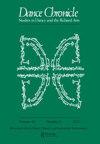Theater Dance’s Material Underneath
IF 0.1
3区 艺术学
0 DANCE
引用次数: 0
Abstract
Arabella Stanger’s first monograph, Dancing on Violent Ground: Utopia as Dispossession in Euro-American Theater Dance, is a brilliant study of the spatial philosophies, practices, and politics underpinning histories of dance as a theatrical art form. For this project, Stanger has built a thorough theoretical apparatus that scaffolds significant contributions to the fields of dance and performance studies through an interdisciplinary approach drawing primarily from critical race theory and Native studies. Employing a materialist attention to both staged and social choreographies of space, Stanger analyzes how theater dance—which she describes as “a nexus of corporeal, discursive, and institutional practices” (p. 4)—enacts and extends violent processes of racialization and dispossession. Dancing on Violent Ground contends that dance “can model harmonic or freeing experiences for dancers and audiences while masking and legitimizing imperial, colonial, and white supremacist practices of space” (p. 4). Stanger makes this argument elegantly and compellingly through her engagement with carefully selected objects of analysis, including the choreographies, drawings, and philosophies of Marius Petipa, Martha Graham, George Balanchine, Rudolf von Laban, Oskar Schlemmer, Merce Cunningham, and Boris Charmatz. Stanger’s theoretical turn to choreographies of space is enriched by a vast archive of historical material that spans multiple continents and several centuries. These examples from ballet, modern, and contemporary dance both prove and further complicate her pertinent critiques of how choreographic cultures uphold the supremacy of whiteness. Despite the temporal and geographic breadth of her research, Stanger’s attention to the pervasive imperial and settler colonial ideologies that pulse throughout the history of Euro-American theater dance provides strong connections among her objects of study. Stanger achieves a clear intervention in the field of dance studies by shifting her analytical attention toward the ways that bodies and戏剧舞蹈的底层材料
阿拉贝拉·斯坦格(Arabella Stanger)的第一本专著《暴力地上的舞蹈:欧美戏剧舞蹈中的乌托邦处置》(Dancing on Violent Ground:Utopia as Disposed in Euro American Theater Dance)对舞蹈作为一种戏剧艺术形式的历史所支撑的空间哲学、实践和政治进行了精彩的研究,斯坦格通过主要借鉴批判性种族理论和本土研究的跨学科方法,建立了一个全面的理论体系,为舞蹈和表演研究领域做出了重大贡献。斯坦格运用唯物主义者对舞台和社会空间编排的关注,分析了戏剧舞蹈——她将其描述为“物质、话语和制度实践的联系”(第4页)——是如何产生和扩展种族化和剥夺的暴力过程的。《暴力场地上的舞蹈》认为,舞蹈“可以为舞者和观众塑造和谐或自由的体验,同时掩盖和合法化帝国主义、殖民主义和白人至上主义的太空实践”(第4页)。斯坦格通过精心挑选的分析对象,包括马里乌斯·佩蒂帕、玛莎·格雷厄姆、乔治·巴兰钦、鲁道夫·冯·拉班、奥斯卡·施莱默、默西·坎宁安和鲍里斯·查马茨的舞蹈、绘画和哲学,优雅而有力地提出了这一论点。斯坦格从理论上转向太空编舞,这得益于跨越多大洲和几个世纪的大量历史材料档案。这些来自芭蕾舞、现代舞和当代舞的例子都证明了她对舞蹈文化如何维护白人至上的中肯批评,并使其进一步复杂化。尽管斯坦格的研究在时间和地理上都很广泛,但她对贯穿欧美戏剧舞蹈史的普遍的帝国和定居者殖民意识形态的关注,为她的研究对象提供了强有力的联系。斯坦格通过将她的分析注意力转移到身体和
本文章由计算机程序翻译,如有差异,请以英文原文为准。
求助全文
约1分钟内获得全文
求助全文
来源期刊

DANCE CHRONICLE
DANCE-
CiteScore
0.40
自引率
0.00%
发文量
22
期刊介绍:
For dance scholars, professors, practitioners, and aficionados, Dance Chronicle is indispensable for keeping up with the rapidly changing field of dance studies. Dance Chronicle publishes research on a wide variety of Western and non-Western forms, including classical, avant-garde, and popular genres, often in connection with the related arts: music, literature, visual arts, theatre, and film. Our purview encompasses research rooted in humanities-based paradigms: historical, theoretical, aesthetic, ethnographic, and multi-modal inquiries into dance as art and/or cultural practice. Offering the best from both established and emerging dance scholars, Dance Chronicle is an ideal resource for those who love dance, past and present. Recently, Dance Chronicle has featured special issues on visual arts and dance, literature and dance, music and dance, dance criticism, preserving dance as a living legacy, dancing identity in diaspora, choreographers at the cutting edge, Martha Graham, women choreographers in ballet, and ballet in a global world.
 求助内容:
求助内容: 应助结果提醒方式:
应助结果提醒方式:


